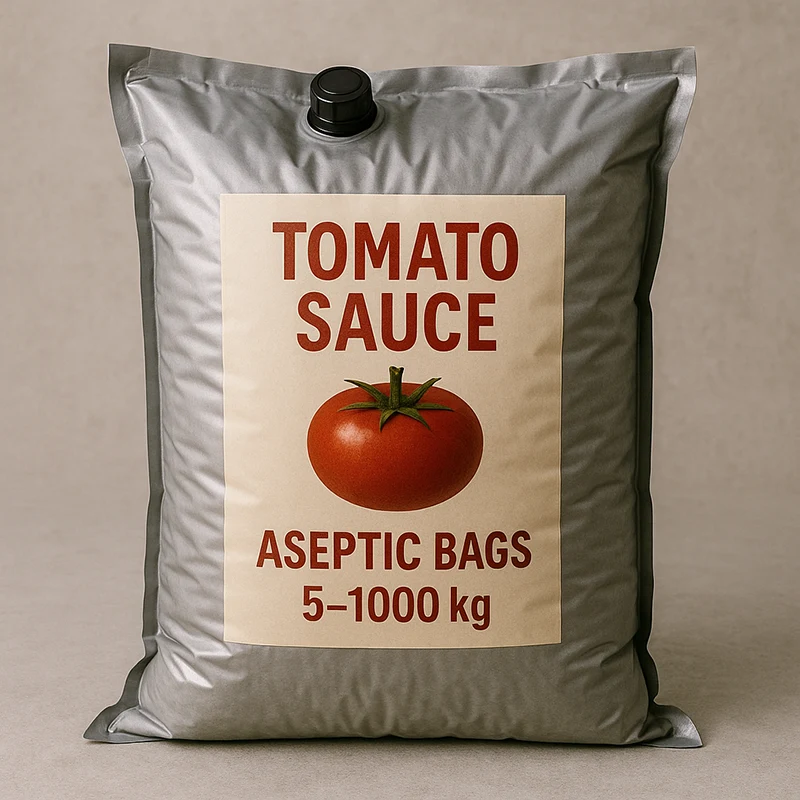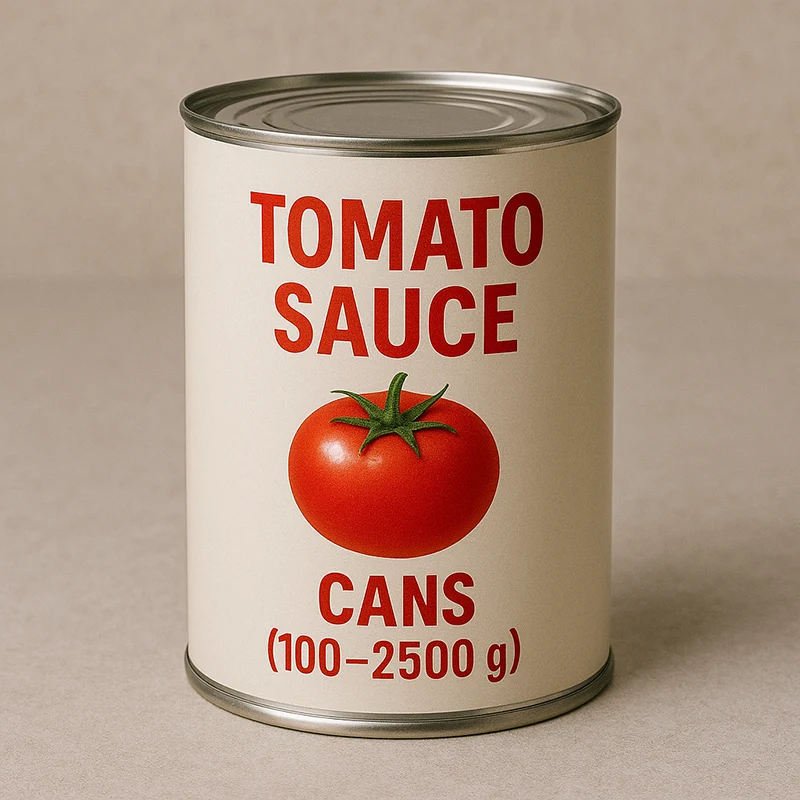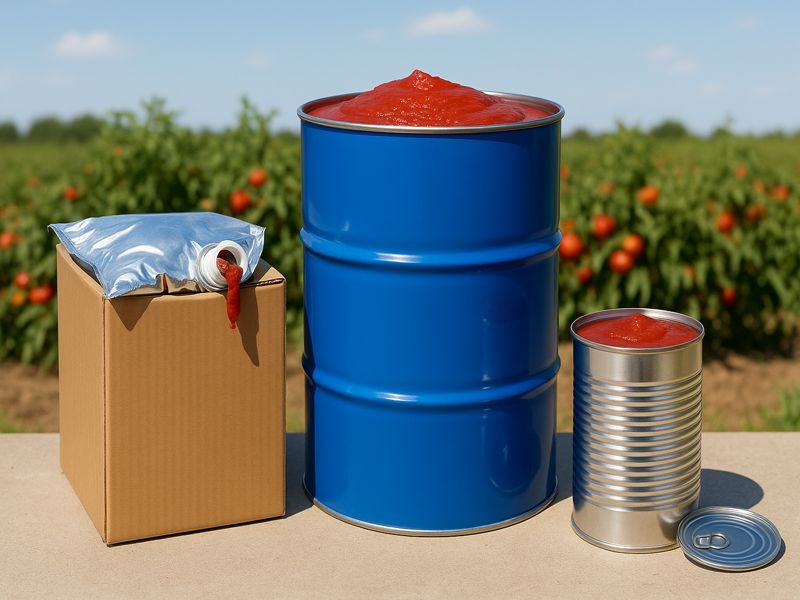Tomato paste is a globally versatile ingredient used in sauces, soups, and ready meals. Its quality depends heavily on packaging, which impacts preservation, flavor, and cost efficiency. With varying concentration levels (28–30%, 36–38%, and 48–50%), the right packaging ensures consistency and safety. This article compares the main options—aseptic bags, drums, and cans—highlighting their advantages and ideal applications.
Key Functions of Tomato Paste Packaging
Packaging in tomato processing serves far more than a storage role. It acts as a protective barrier against physical, chemical, and microbial threats that could compromise the product’s integrity.
The main functions include:
- Protection from oxygen and light: Prevents oxidation that leads to color fading and off-flavors.
- Preservation of flavor and consistency: Keeps the natural viscosity and taste stable during transport.
- Microbial safety: Sterile packaging ensures product safety without the need for preservatives.
- Ease of transportation and handling: Enables efficient loading, stacking, and export logistics.
- Extended shelf life: Minimizes spoilage and waste, especially for bulk industrial applications.
The right packaging must therefore strike a balance between durability, sterility, and cost efficiency, depending on the concentration and intended market of the tomato paste.
Understanding the Main Packaging Options
Tomato paste packaging can be broadly categorized into three major formats:
- Aseptic Bags — flexible sterile bags used in bag-in-box or bag-in-drum systems.
- Drums — rigid metal or plastic containers, often lined with aseptic bags or coatings.
- Cans — small tin or aluminum containers designed for retail and catering use.
Each type is engineered for a specific volume range, shelf life expectation, and market segment.
| Packaging Type | Typical Capacity | Target User | Shelf Life | Best For |
| Aseptic Bags | 220–1,000 kg | Industrial / Export | 18–24 months | Bulk shipping, high-Brix paste |
| Drums | 220–240 kg | Industrial | 18–24 months | Concentrated paste and reprocessing |
| Cans | 70 g – 5 kg | Retail / Food Service | 12–18 months | Consumer markets |

Aseptic Bags: Modern and Hygienic Bulk Packaging
Aseptic packaging has revolutionized the tomato paste industry by combining sterility and flexibility. The product is filled into pre-sterilized multi-layer bags under aseptic conditions, ensuring no contact with contaminants.
These bags are usually placed inside metal drums, corrugated boxes, or intermediate bulk containers (IBC). The structure includes aluminum foil and polyethylene layers that create an oxygen and light barrier, protecting flavor and nutrients.
Key Advantages
- Long shelf life: Up to 24 months without refrigeration or preservatives.
- High hygiene standards: Ideal for export and industrial use.
- Space and weight efficiency: Lighter than drums, reducing freight costs.
- Easy discharge: Compatible with automatic filling and pumping systems.
Limitations
- Requires aseptic filling lines, increasing equipment investment.
- Careful handling is necessary to prevent punctures or seal failure.
| Attribute | Aseptic Bags |
| Capacity | 220–1,000 kg |
| Material | Multi-layer (PE + Aluminum) |
| Filling | Aseptic / Sterile |
| Storage | Ambient (Cool & Dry) |
| Shelf Life | Up to 24 months |
| Application | Industrial production, exports, ketchup, and sauces |
Aseptic bags are particularly preferred for 36–38% and 48–50% concentrated tomato paste, where extended storage and transport stability are crucial.
Drums: Durable Solution for Industrial Bulk
Drums remain one of the most traditional yet reliable bulk packaging options in the tomato processing sector. They are typically made of steel or high-density polyethylene (HDPE) and may include epoxy resin linings or aseptic inner bags to prevent corrosion and contamination.
Features and Benefits
- Robust protection: Excellent for long-distance shipment and harsh handling conditions.
- Versatile capacity: Standardized for 220–240 kg of concentrated paste.
- Stackable design: Suitable for palletized storage in warehouses.
- Reusable: Metal drums can be reconditioned for multiple cycles, supporting sustainability goals.
Limitations
- Heavier than flexible packaging, which increases transportation costs.
- Requires more storage space and manual handling compared to bag-in-box systems.
- Metal drums may rust without proper lining or humidity control.
| Attribute | Drums |
| Capacity | 220–240 kg |
| Material | Steel or HDPE |
| Shelf Life | 18–24 months (aseptic) |
| Reusability | High |
| Weight | Heavy |
| Ideal Use | Industrial bulk handling, long-distance transport |
For manufacturers of concentrated paste (especially 48–50% Brix), drums remain a dependable choice, particularly for regions where mechanical handling equipment is standard.

Cans: Ideal for Retail and Food Service
Canned tomato paste remains a staple in global retail markets, catering to households, restaurants, and small-scale food service providers. Usually constructed of aluminum or tin-plated steel, cans are hermetically sealed and sanitized once they are filled.
Advantages
- Ready-to-use: No dilution or special handling required.
- Excellent consumer presentation: Ideal for branding and labeling.
- Portion control: Available in small units from 70 g to 5 kg.
- High protection: Blocks light and air completely, preserving color and taste.
Limitations
- Not reusable and generates more packaging waste.
- Shorter shelf life once opened due to exposure to air.
- Higher production cost per kilogram compared to bulk formats.
| Attribute | Cans |
| Capacity | 70 g – 5 kg |
| Material | Tin-plated steel or aluminum |
| Shelf Life | 12–18 months |
| Application | Retail, restaurant, catering |
| Advantage | Attractive packaging, consumer-ready |
| Limitation | Limited volume, non-reusable |
Cans are most often used for 28–30% cold break paste, where consumer convenience and taste freshness are prioritized.
Comparative Analysis: Choosing the Right Format
Selecting between aseptic bags, drums, and cans depends on multiple factors such as end-user requirements, logistics, shelf life expectations, and concentration level.
| Packaging Type | Best For | Shelf Life | Reuse | Cost | Storage Efficiency | Key Benefit |
| Aseptic Bags | Export & industrial | ★★★★★ | No | Low | High | Sterile, lightweight |
| Drums | Industrial & bulk logistics | ★★★★☆ | Yes | Medium | Medium | Durable & reusable |
| Cans | Retail & catering | ★★★☆☆ | No | High | Low | Consumer convenience |
Key takeaways:
- Aseptic bags dominate bulk international exports due to sterility and lightweight transport.
- Drums are ideal for regional industrial users seeking reusability and ruggedness.
- Cans serve retail and food service sectors demanding smaller, branded packaging.
Packaging Material Considerations
Each packaging material provides a specific barrier performance against oxygen, light, and moisture — all of which are crucial for tomato paste preservation.
Aseptic Bags
- Multi-layer construction (polyethylene + aluminum) ensures low oxygen permeability.
- The inner PE layer provides food contact safety, while the outer aluminum shields against UV exposure.
Drums
- Steel drums require food-grade epoxy coating to prevent corrosion.
- HDPE drums offer lightweight, rust-free alternatives.
- Aseptic liners can be inserted to enhance sterility.
Cans
- Tin coating prevents oxidation of both product and metal.
- Double-seamed lids guarantee airtight sealing.
- Interior lacquer coatings protect flavor and color stability.
Modern tomato paste processors are also exploring eco-friendly alternatives, including recyclable film layers, lightweight metals, and bio-based plastics to meet environmental regulations.
Storage and Transportation Requirements
Proper storage and logistics management are vital for maintaining tomato paste quality.
Recommended Conditions
| Packaging | Storage Temperature | Humidity | Handling Notes |
| Aseptic Bags | 5–25°C | <65% RH | Keep sealed; avoid punctures |
| Drums | 10–30°C | <70% RH | Avoid direct sunlight; stack safely |
| Cans | 5–25°C | <60% RH | Protect from dents or corrosion |
Transportation Tips
- Use palletized stacking for stability during shipment.
- Employ temperature-controlled containers for long-distance export.
- For aseptic bags, ensure valves and seals are tested before loading.
- Maintain traceability via barcodes or RFID tags for quality assurance.
Cost and Efficiency Factors
Cost evaluation in tomato paste packaging involves not only the price of materials but also handling, shipping, and storage efficiency.
| Cost Factor | Aseptic Bag | Drum | Can |
| Material Cost | Low–Medium | Medium | High |
| Transport Cost | Lowest (lightweight) | Moderate | High |
| Equipment Cost | High (aseptic filler) | Moderate | Low |
| Labor Requirement | Low | Medium | High |
| Space Efficiency | Excellent | Medium | Poor |
Analysis:
- Aseptic systems require a higher initial investment but offer the lowest operational costs in the long run.
- Drums provide a middle ground between durability and logistics cost.
- Cans, while expensive, generate the highest retail margins through consumer sales.
For manufacturers focused on exports or large-scale industrial supply, aseptic packaging delivers the best cost-performance balance. For smaller factories serving local markets, drums may remain more practical.
New Developments in the Packaging of Tomato Paste
Smarter, greener, and more effective packaging options are quickly becoming the norm in the tomato processing sector.
1. Sustainability
- Adoption of biodegradable liners, recyclable aluminum, and reusable drums.
- Reduction in packaging weight to minimize carbon footprint.
2. Automation
- Fully automated aseptic filling systems improve sterility and reduce human error.
- Robotic palletizing enhances handling efficiency.
3. Astute Packaging
- IoT sensor integration for real-time temperature, pressure, and oxygen level monitoring.
- Utilizing QR codes to increase consumer transparency and product traceability.
4. Flexible Intermediate Bulk Containers (IBC)
- Emerging as an alternative to traditional drums, offering larger volume capacity (up to 1,200 L) and improved shipping efficiency.
As global trade expands, packaging innovation continues to focus on energy efficiency, safety, and sustainability to meet the demands of both manufacturers and regulators.
Packaging plays a decisive role in determining the quality, shelf life, and cost-efficiency of tomato paste. The choice between aseptic bags, drums, and cans should align with each producer’s target market, concentration level, and logistics chain.
- Aseptic bags offer the highest sterility, longest shelf life, and best bulk export efficiency.
- Drums provide mechanical protection and reusability for regional industrial buyers.
- Cans remain indispensable for consumer markets, where convenience and presentation drive sales.
For tomato paste manufacturers, exporters, and distributors, the right packaging decision ensures that every batch — whether 28–30% cold break or 48–50% concentrated paste — reaches its destination with preserved flavor, vibrant color, and consistent texture.


